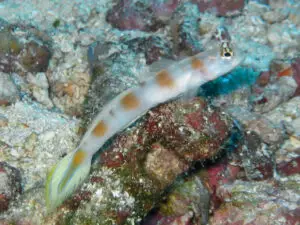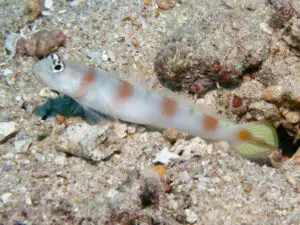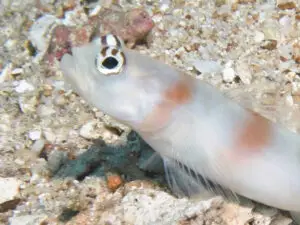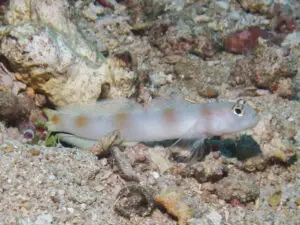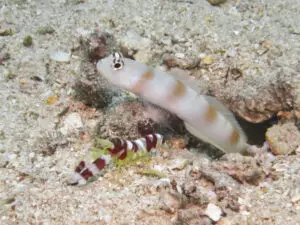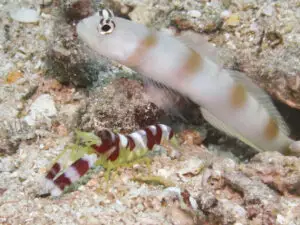Flagtail Shrimpgoby
Amblyeleotris yanoi
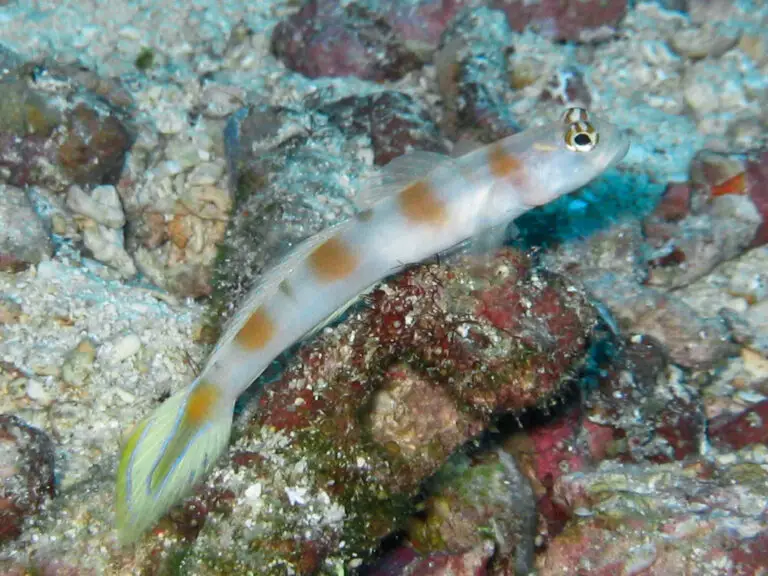
Flagtail Shrimpgoby
Amblyeleotris yanoi
Aonuma and Yoshino, 1996
Description
Body design
This is a medium sized goby up to 10mm in length. The body is white with five pale edged brown bars, the last one being incorporated into the design of the flag tail. In some of the spaces between the brown bars are black saddles. The body is otherwise plain.
The head is plain white with a very faint yellow line running up and back from behind the eye and a suggestion of fainter yellow spots on the gill cover. These are frequently invisible. Two very narrow red lines passing forward from the anterior margin of the eye to the upper lip are described in the type description but we do not see these. .
Fin design
The first dorsal fin is translucent and evenly curved with a slightly scalloped edge from the first spine to the posterior junction, without projecting spines. The second dorsal fin is translucent pale yellow with a translucent blue edge and a yellow subterminal line. .
The most striking feature is the caudal fin which is broad and spear shaped, yellow with a brown edge and a brown mid line stripe that runs into the brown bar at the base. A blue line encircles the yellow, separating it from the brown. The pectoral fins are transparent, the pelvic fin is transparent. and the anal fin Is pale yellow.
Diagnostic features
The main features are the pale bands on the otherwise unmarked body and, of course, the flag tail.
Fishbase EOL Associated with Alpheus randalli, the red-banded alpheid shrimp, on coastal sand flats, slopes and in deep lagoons at depths of about 3 to 30m. Inhabits coastal sand slopes in 6 to 30m depth.
max size 61. 7mm SL13. 0 cm SL male/unsexed, 5. 75 cm SL female
Characterised by whitish body colour with five light orange-brown, diffuse bars; brown saddles dorsally between main dark bars; caudal fin yellow with reddish orange central area and oblique blue bands; pelvic fins joined by low membrane, absence of frenum; longitudinal scale series 97-103; midline of nape without scales; scales on side of nape extending forward to above posterior margin of operculum; greatest depth of body 7. 7-8. 2 in SL; lanceolate caudal fin, longer than head.
Similar species
Distinguished from the following by these characters:
A. aurora Red line on tip of maxilla, body bars broader than interspaces, different pattern on caudal fin.
A. novaecaledoniae Caudal fin colour pattern, Two large elongate markings on lower part.
Taxonomy
Type description Aonuma and Yoshino 1996 Two new species of the genus Amblyeleotris from the Ryukyu Islands, Japan. Ichthyological Research 43 (2): 161-168
Natural History
Habitat
Described as being found at 3 to 35 m.
In our experience they form very localised colonies on coarse sand among small bommies on broad terraces on the seaward aspect of lagoon reefs, at a depth of 15 to 20m.
Behaviour
A colony we are familiar with is restricted to a 30 square metre patch in the middle of a vast area of apparently uniform habitat. The wider area is colonised by Amblyeleotris guttata accompanied by five species of shrimp, but not Randall’s shrimp. The A yanoi colony is only associated with Randall’s shrimp. This demarcation is remarkable given the randomness of planktonic spread of the unrelated embryos prior to settlement on the reef.
We have only recorded A yanoi with Randall’s shrimp, and have not recorded A guttata with this species.
At times they stray into the territory of A guttata. When this happens they both display with erect fins and widely gaping mouths, before the stray returns to its own patch.
They seem to spend long periods of time sealed in their burrows in daytime.
Distribution
Published distribution:
Bali in Indonesia to Palau and Papua New Guinea and north to southwest Japan.
Our records: (Range Extension)
Our observations extend the range to include the Solomon Islands.
Associated Shrimp species
Associated Shrimp (one shrimp)
Randall’s Snapping Shrimp, Alpheus randalli

